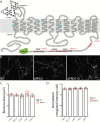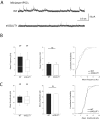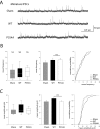A proline-rich motif on VGLUT1 reduces synaptic vesicle super-pool and spontaneous release frequency
- PMID: 31663854
- PMCID: PMC6861006
- DOI: 10.7554/eLife.50401
A proline-rich motif on VGLUT1 reduces synaptic vesicle super-pool and spontaneous release frequency
Abstract
Glutamate secretion at excitatory synapses is tightly regulated to allow for the precise tuning of synaptic strength. Vesicular Glutamate Transporters (VGLUT) accumulate glutamate into synaptic vesicles (SV) and thereby regulate quantal size. Further, the number of release sites and the release probability of SVs maybe regulated by the organization of active-zone proteins and SV clusters. In the present work, we uncover a mechanism mediating an increased SV clustering through the interaction of VGLUT1 second proline-rich domain, endophilinA1 and intersectin1. This strengthening of SV clusters results in a combined reduction of axonal SV super-pool size and miniature excitatory events frequency. Our findings support a model in which clustered vesicles are held together through multiple weak interactions between Src homology three and proline-rich domains of synaptic proteins. In mammals, VGLUT1 gained a proline-rich sequence that recruits endophilinA1 and turns the transporter into a regulator of SV organization and spontaneous release.
Keywords: Vesicular Glutamate Transporter; axon; cell biology; liquid phase separation; mouse; neuroscience; neurotransmission; proline-rich domain; synaptic vesicle pools.
© 2019, Zhang et al.
Conflict of interest statement
XZ, UF, KS, MA, MF, MM, CM, VB, FC, MD, SP, UM, AB, SW, SE, YH, EH No competing interests declared
Figures











Similar articles
-
A role for vesicular glutamate transporter 1 in synaptic vesicle clustering and mobility.Eur J Neurosci. 2013 May;37(10):1631-42. doi: 10.1111/ejn.12199. Epub 2013 Apr 15. Eur J Neurosci. 2013. PMID: 23581566
-
Protein interactions of the vesicular glutamate transporter VGLUT1.PLoS One. 2014 Oct 15;9(10):e109824. doi: 10.1371/journal.pone.0109824. eCollection 2014. PLoS One. 2014. PMID: 25334008 Free PMC article.
-
Colocalization of different neurotransmitter transporters on synaptic vesicles is sparse except for VGLUT1 and ZnT3.Neuron. 2022 May 4;110(9):1483-1497.e7. doi: 10.1016/j.neuron.2022.02.008. Epub 2022 Mar 8. Neuron. 2022. PMID: 35263617
-
Vesicular glutamate transporters as anion channels?Pflugers Arch. 2016 Mar;468(3):513-8. doi: 10.1007/s00424-015-1760-y. Epub 2015 Nov 17. Pflugers Arch. 2016. PMID: 26577586 Review.
-
Synaptic Vesicle Clusters at Synapses: A Distinct Liquid Phase?Neuron. 2017 Mar 8;93(5):995-1002. doi: 10.1016/j.neuron.2017.02.013. Neuron. 2017. PMID: 28279363 Free PMC article. Review.
Cited by
-
Tau forms synaptic nano-biomolecular condensates controlling the dynamic clustering of recycling synaptic vesicles.Nat Commun. 2023 Nov 10;14(1):7277. doi: 10.1038/s41467-023-43130-4. Nat Commun. 2023. PMID: 37949856 Free PMC article.
-
Dipping contacts - a novel type of contact site at the interface between membraneless organelles and membranes.J Cell Sci. 2023 Dec 15;136(24):jcs261413. doi: 10.1242/jcs.261413. Epub 2023 Dec 27. J Cell Sci. 2023. PMID: 38149872 Free PMC article.
-
Directly reprogrammed fragile X syndrome dorsal forebrain precursor cells generate cortical neurons exhibiting impaired neuronal maturation.Front Cell Neurosci. 2023 Sep 21;17:1254412. doi: 10.3389/fncel.2023.1254412. eCollection 2023. Front Cell Neurosci. 2023. PMID: 37810261 Free PMC article.
-
Investigate Synaptic Vesicles Mobility in Neuronal Culture Axons by FRAP Imaging.Bio Protoc. 2021 Mar 20;11(6):e3962. doi: 10.21769/BioProtoc.3962. eCollection 2021 Mar 20. Bio Protoc. 2021. PMID: 33855120 Free PMC article.
-
Synaptic Vesicle Recycling and the Endolysosomal System: A Reappraisal of Form and Function.Front Synaptic Neurosci. 2022 Feb 25;14:826098. doi: 10.3389/fnsyn.2022.826098. eCollection 2022. Front Synaptic Neurosci. 2022. PMID: 35280702 Free PMC article. Review.
References
-
- Bardy C, van den Hurk M, Eames T, Marchand C, Hernandez RV, Kellogg M, Gorris M, Galet B, Palomares V, Brown J, Bang AG, Mertens J, Böhnke L, Boyer L, Simon S, Gage FH. Neuronal medium that supports basic synaptic functions and activity of human neurons in vitro. PNAS. 2015;112:E2725–E2734. doi: 10.1073/pnas.1504393112. - DOI - PMC - PubMed
-
- Berger A, Lorain S, Joséphine C, Desrosiers M, Peccate C, Voit T, Garcia L, Sahel JA, Bemelmans AP. Repair of rhodopsin mRNA by spliceosome-mediated RNA trans-splicing: a new approach for autosomal dominant retinitis pigmentosa. Molecular Therapy. 2015;23:918–930. doi: 10.1038/mt.2015.11. - DOI - PMC - PubMed
Publication types
MeSH terms
Substances
Grants and funding
- ANR-12-JSV4-0005-01 VGLUT-IQ/Agence Nationale de la Recherche/International
- ANR-10-LABX-43 BRAIN/Agence Nationale de la Recherche/International
- ANR-10-IDEX-03-02 PEPS SV-PIT/Agence Nationale de la Recherche/International
- PSYVGLUT 09-MNPS-033/Agence Nationale de la Recherche/International
- ANR-10-INBS-04/Agence Nationale de la Recherche/International
LinkOut - more resources
Full Text Sources
Other Literature Sources
Molecular Biology Databases
Miscellaneous

